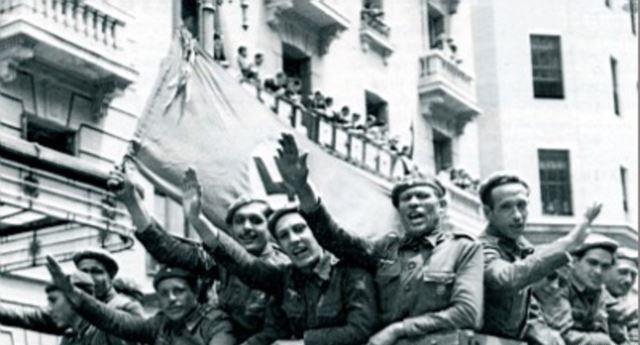Surely many people do not know what collaboration is, and they hear this word for the first time. In the legal interpretation, this is voluntary, deliberate, intentional cooperation with enemies in their interests and to the detriment of their country, in other words - high treason. This term was first spoken during World War II, in 1940, when Marshal Petain, head of the Vichy regime, called on the French nation to collaborate with the German authorities during the occupation of France.
Later, what collaborationism was learned in other countries. The term began to apply to all European governments operating under German occupation (the Lokot republic regime, the Quisling government in Norway, the activities of the “Melnikovites” in the USSR, etc.), as well as to Hitler’s block-controlled military organizations of citizens of occupied countries (national SS divisions, Vlasov’s army, etc.).
Collaborationism in the Second World War
The historical science, fiction, and journalistic works widely cover the heroism of millions of people during the war - sometimes genuine, sometimes mythologized, sometimes imaginary. But there were other people - those who collaborated with the Nazis, trying by any means to survive in the conditions of the occupation regime. Now it is often possible to meet historians' statements that the Soviet Union was a country of traitors, supposedly hundreds of thousands of our fellow citizens stood under the banners of the Third Reich, thus trying to fight the hated Stalinist regime. Is it really? Was Russian collaborationism really so massive? Let's try to figure it out.
Cooperation with the Nazis
It would be pointless to deny that collaborationism took place in World War II. It is known for certain that several tens of thousands of Russian citizens who joined the units of the ROA (Russian Liberation Army) in February 1945, with arms in their hands, tried to stop the victorious attack on Berlin of our army. And how many traitors were there? By February of the 45th ROA had two formed divisions, including about forty thousand people, and one unformed, numbering ten to twelve thousand soldiers. Also nominally adjacent to the ROA was the Helmut von Pannwitz Cossack Corps, consisting of forty-five thousand people, and the Russian corps formed from emigrants, who fought in Serbia, which included about six thousand soldiers. Thus, the total number of ROA units was within one hundred and twenty thousand people. In various collaborative services throughout the USSR, a total of up to eight hundred thousand fighters were involved (according to German data). That's all!

Types of collaboration
It should be said that high treason is different: administrative, intellectual, military, economic, spiritual, ideological, national, sexual, childish. So, some people collaborated with enemies with weapons in their hands - this is military collaboration. In the USSR, France and other countries during the Second World War there was another category of people who provided their intellect to serve the enemy: the spiritual power of a priest, the skill of an actor, the talent of a worker. As for children's collaboration, it seems to have been thoughtless. German officers picked up thousands of Russian hungry children, fed, and then gave pieces of TNT and offered to toss them at the railway stations to heaps of coal. Almost all the children did not complete the task, and those who performed probably did it out of folly.
Love and Germans
And how did sexual collaboration appear in World War II? Europe needed people with good blood. Remember the soloist of the Swedish ABBA band Annie-Fried Lingstad? She is just the product of sexual collaboration. Her father is a German soldier, and her mother is a Norwegian. Russian ladies from a racial point of view did not meet the requirements of the Third Reich. There were even orders forbidding the German invaders to cohabit with our women in order to avoid damage to Aryan blood. However, in practice the situation was different. There were certain contradictions between people who looked at the front from deep rear and those who were in its very hell. For example, in Orel, General Hamann, the German commandant, announced that if a woman proves that she has given birth to a child from a German soldier, she will receive child support from the German command.
Violence
They knew about what collaborationism was in all European countries, but they dealt with traitors everywhere in different ways. For example, in Norway, a person who simply answered the German’s greeting would have to publicly repent. What can we say about active accomplices. They were sentenced to death, imprisoned. It was the same in the Soviet Union. Even in the post-war period, people who were previously in the occupied territories should have reflected this fact in questionnaires. It was a black mark, the so-called Kain seal, signaling that such a person should be treated with caution.
Finally
And what is collaboration in the understanding of modern people? For example, now in the Baltic countries collaborators are called liberators. They are proclaimed heroes and freedom fighters. Fortunately, there are a minority of people who advocate this point of view. We should not heroize the criminals who fought on the side of the Nazis with weapons in their hands. We must not allow that, after decades from the day of the victory, they tried to steal it from us!